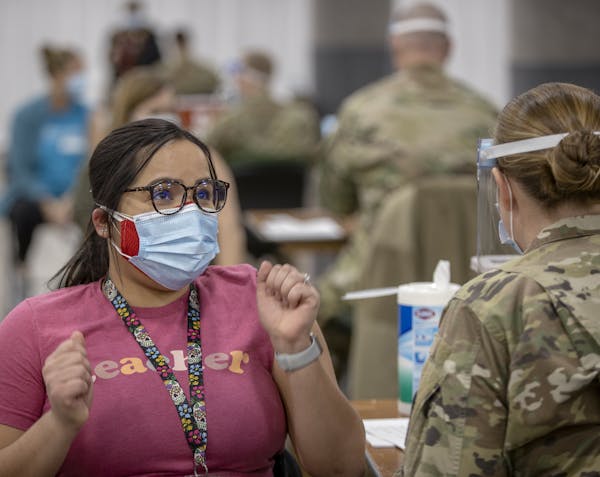A COVID-19 outbreak among bus drivers and transportation staff has forced Bloomington Public Schools to abruptly move elementary students back to distance learning, less than two weeks after schools reopened for in-person instruction.
The district was one of many in Minnesota that began reopening elementary schools this month following a change in state guidelines. Now, it's the first in the metro area to reverse course because of widespread virus activity. The move comes as other large districts, including Minneapolis and St. Paul, are preparing to bring students back to classrooms and fielding significant safety concerns from teachers and their unions.
Bloomington school leaders notified families Thursday evening that classes would be moved online starting Friday and remain that way for two weeks. Older elementary students had been scheduled to return to schools Feb. 1, but now that's been delayed, too. All elementary and early childhood students will be out of classrooms until Feb. 12.
Rick Kaufman, the district's community relations director and emergency management coordinator, said eight transportation staff members tested positive for COVID-19 and about a dozen more are in quarantine because of close contact with people with the virus. The outbreak involves bus drivers as well as dispatchers, trainers and clerical staff — people who often serve as substitutes when regular drivers are unavailable. Because schools are required by federal law to provide transportation, the district couldn't make other plans, like asking parents to drop off students.
"When you have a significant outbreak of that nature, we can't provide the service for our students that were returned to school," he said.
Some students and staff outside of the transportation department have tested positive or had to quarantine since classrooms reopened, but not enough to warrant a change in learning model, Kaufman said. The district believes the safety protocols required by the state, including distancing, mask wearing and testing for school staff, have been effective and that schools could have remained open if not for the outbreak.
Kaufman said it appears that a staff member contracted COVID-19 outside school and then brought the virus to work. He said that's the major challenge for schools in the pandemic; as the virus spreads in the community, staff and students pick it up elsewhere and bring it to school buildings, forcing repeated and sometimes abrupt shifts between distance, hybrid and in-person learning. Bloomington brought back its youngest students on Jan. 19.
"We were feeling good about what was going on, and it's really tough to switch," he said. "That's what we're feeling today and what we're hearing from parents. Some are angry, some are upset, and we totally get it."
Meanwhile, teachers unions in the Minneapolis and St. Paul school districts, which both plan to bring elementary students back to classrooms in February, are pushing back on their districts' plans.
During a news conference Friday, Nick Faber, president of the St. Paul Federation of Educators (SPFE), said the Bloomington setback showed why St. Paul should delay plans to reopen schools to its youngest learners Monday.
"What's best for our students?" he said. "For them to have to come back and be with a teacher that they haven't been with all year only to be bounced out again?"
District leaders have worked for weeks to get schools ready and to fine-tune daily operations. But union members question whether the return is a sound move academically and whether students and staff will be safe. As of Friday morning, Faber said, a running tally showed nine of 10 SPFE members had "no confidence" in the district's plans to resume in-person learning.
Superintendent Joe Gothard said in a statement that his team has met with SPFE leaders since the beginning of the school year — agreeing to steps that address such things as bus and classroom safety — and he was hopeful they could continue to work together to "build upon what's best for our students."
The Minneapolis Federation of Teachers is challenging the Minneapolis Public Schools' reopening plan through a number of routes, including an unfair labor practice charge with the Public Employment Relations Board and a request for a court order that would block the district from reassigning teachers to work in person, which the union says is a violation of its labor contract.
In a news conference Friday, Minneapolis union members said they are concerned about uneven processes for teachers requesting accommodations because they are at high risk of COVID-19 complications. They're also troubled by the number of teachers who have abruptly been reassigned to new classrooms, or even to teach a different grade level.
Greta Callahan, the union's president, said as of Friday some teachers still didn't know what they will be teaching or who will be in their class.
Lindsey West, who teaches fifth grade at Clara Barton Open School, said she's received directions to work in person, even though she'll be teaching students learning from home. She doesn't know what duties she'll be assigned on top of that, like helping out in the cafeteria.
"All of that uncertainty in your job, with a week to go before you even know if it's all happening, and you're thinking about your family and how much exposure you might be bringing home — that's a real problem," she said. "That's why as educators, we are beside ourselves."
Staff writer Anthony Lonetree contributed to this report.
Erin Golden • 612-673-4790
Oakdale issues warning after coyote attacks dog in nature preserve

Anoka County extends search for county administrator

Minneapolis schools, teachers reach tentative agreement to avert strike

